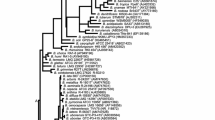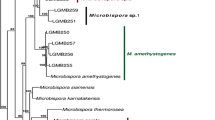Abstract
To construct an evolutionary hypothesis for the genus Frankia, gyrB (encoding gyrase B), nifH (encoding nitrogenase reductase) and glnII (encoding glutamine synthetase II) gene sequences were considered for 38 strains. The overall clustering pattern among Frankia strains based on the three analyzed sequences varied among themselves and with the previously established 16S rRNA gene phylogeny and they did not reliably reflect clear evolution of the four discerned Frankia clusters (1, 2, 3 and 4). Based on concatenated gyrB, nifH and glnII, robust phylogenetic trees were observed with the three treeing methods (Maximum Likelihood, Parsimony and Neighbor-Joining) and supported by strong bootstrap and posterior probability values (>75%) for overall branching. Cluster 4 (non-infective and/or non-nitrogen-fixing Frankia) was positioned at a deeper branch followed by cluster 3 (Rhamnaceae and Elaeagnaceae infective Frankia), while cluster 2 represents uncultured Frankia microsymbionts of the Coriariaceae, Datiscaceae, Rosaceae and of Ceanothus sp. (Rhamnaceae); Cluster 1 (Betulaceae, Myricaceae and Casuarinaceae infective Frankia) appears to have diverged more recently. The present study demonstrates the utility of phylogenetic analyses based upon concatenated gyrB, nifH and glnII sequences to help resolve previously unresolved or poorly resolved nodes and will aid in describing species among the genus Frankia.


Similar content being viewed by others
References
Akimov VN, Dobritsa SV (1992) Grouping of Frankia strains on the basis of DNA relatedness. Syst Appl Microbiol 15:372–379
Benson DR, Silvester WB (1993) Biology of Frankia strains, actinomycete symbionts of actinorhizal plants. Microbiol Rev 57:293–319
Clawson ML, Bourret A, Benson DR (2004) Assessing the phylogeny of Frankia-actinorhizal plant nitrogen-fixing root nodule symbioses with Frankia 16S rRNA and glutamate synthetase gene sequences. Mol Phyl Evol 31:131–138
Counoyer B, Normand P (1994) Characterization of a spontaneous thiostrepton-resistant Frankia alni infective isolate using PCR-RFLP of nif and glnII genes. Soil Biol Biochem 26:553–559
Cournoyer B, Lavire C (1999) Analysis of Frankia evolution radiation using glnII sequences. FEMS Microbiol Lett 117:29–34
Dobritsa SV (1998) Grouping of Frankia strains on the basis of susceptibility to antibiotics, pigment production and host specificty. Int J Syst Bacteriol 48:1265–1275
Fernandez MP, Meugnier H, Grimont AD, Bardin R (1987) Deoxyribonucleic acid relatedness among members of the genus Frankia. Int J Syst Bacteriol 39:424–429
Ghodhbane-Gtari F, Nouioui I, Chaïer M, Boudabous A, Gtari M (2010) 16S–23S rRNA intergenic spacer region variability in the genus Frankia. Microbiol Ecol 60:486–495
Girgis ZGM, Ishac ZY, El-Haddad M, Saleh AE, Diem HG, Dommergues RY (1990) First report on isolation and culture of effective Casuarina-compatible strains of Frankia from Egypt. In: El-Lakany MH, Turnbull JW, Bewbaker TL (Eds.) Advances in Casuarina research and utilisation. Desert Development Center, AUC, Cairo, pp 156–164
Gtari M, Brusetti L, Gharbi S, Diego M, Boudabous A, Daffonchio D (2004) Isolation of Elaeagnus-compatible Frankia from soils collected in Tunisia. FEMS Microbiol Lett 234:349–355
Gtari M, Brusetti L, Hassen A, Mora D, Daffonchio D, Boudabous A (2007) Genetic diversity among Elaeagnus compatible Frankia strains and sympatric related nitrogen-fixing actinobacteria revealed by nifH sequence analysis. Soil Biol Biochem 39:372–377
Huguet V, Gouy M, Normand P, Zimpfer JF, Fernandez MP (2005) Molecular phylogeny of Myricaceae: a reexamination of host-symbiont specificity. Mol Phylogenet Evol 34:557–568
Jeong SC, Ritchie NJ, Myrold DD (1999) Molecular phylogenies of plant and Frankia support multiple origins of actinorhizal symbioses. Mol Phyl Evol 13:493–502
Lalonde M, Simon L, Bousquet J, Siguin A (1988) Advances in the taxonomy of Frankia: recognition of species alni and elaeagni and novel subspecies pommerii and van dijkii. In: Bothe H, de Bruijn FJ, Newton WE (eds) Nitrogen fixation: hundred years after. Gustav Fischer Verlag, New York, pp 671–680
Lawrence JG (1999) Gene transfer, speciation, and the evolution of bacterial genomes. Curr Opin Microbiol 2:519–523
Lawrence JG, Retchless AC (2009) The interplay of homologous recombination and horizontal gene transfer in bacterial speciation. Methods Mol Biol 532:29–53
Lechevalier MP (1994) Taxonomy of the genus Frankia (Actinomycetales). Int J Syst Bacteriol 44:1–8
Lumini E, Bosco M, Fernandez MP (1996) PCR-RFLP and total DNA homology revealed three related genomic species among broad-host-range Frankia strains. FEMS Microbiol Ecol 21:303–311
Normand P, Simonet P, Bardin R (1988) Conservation of nif sequences in Frankia. Mol Gen Genet 213:238–246
Normand P, Orso S, Cournoyer B, Jeannin P, Chapelon C, Dawson JO, Evtushenko L, Mirsra AK (1996) Molecular phylogeny of the genus Frankia and related genera and emendation of the family Frankiaceae. Int J Syst Bacteriol 46:1–9
Tamura K, Peterson D, Peterson N, Stecher G, Nei M, Kamur S (2011) MEGA5: molecular evolutionary genetics analysis using maximum likelyhood, evolutionary distance, and maximum parsimony methods. Mol Biol Evol. doi:10.1093/molbev/msr121
Thompson JD, Gibson TJ, Plewniak F, Jeanmougin F, Higgins DG (1997) The ClustalX windows interface: flexible strategies for multiple sequence alignment aided by quality analysis tools. Nucleic Acids Res 25:876–4882
Valdés M, Pérez NM, de los Santo PE, Mellado JC, Cabrielas JJP, Normand P, Hirsh M (2005) Non-Frankia Actinomycetes isolated from surface sterilized roots of Casuarina equisetifolia fix nitrogen. Appl Environ Microbiol 71:460–466
Acknowledgments
This work was supported by a grant from the High education and scientific research ministry of Tunisia. The authors were grateful to Professor D. P. Labeda (NRRL bacterial collection) for supplying Frankia strains and to Pr. K. F. Benbrahim and Pr. A. Ennabili (University of Fes, Morocco) and Pr. T. Yamanaka (Forest and Forestry Products Research Institute, Japan), Mr. Spick (Montpellier Botanical garden, France) and Mr. D. Moukouanga (IRD Montpellier, France) for providing Coriaria nodules.
Author information
Authors and Affiliations
Corresponding author
Rights and permissions
About this article
Cite this article
Nouioui, I., Ghodhbane-Gtari, F., Beauchemin, N.J. et al. Phylogeny of members of the Frankia genus based on gyrB, nifH and glnII sequences. Antonie van Leeuwenhoek 100, 579–587 (2011). https://doi.org/10.1007/s10482-011-9613-y
Received:
Accepted:
Published:
Issue Date:
DOI: https://doi.org/10.1007/s10482-011-9613-y




